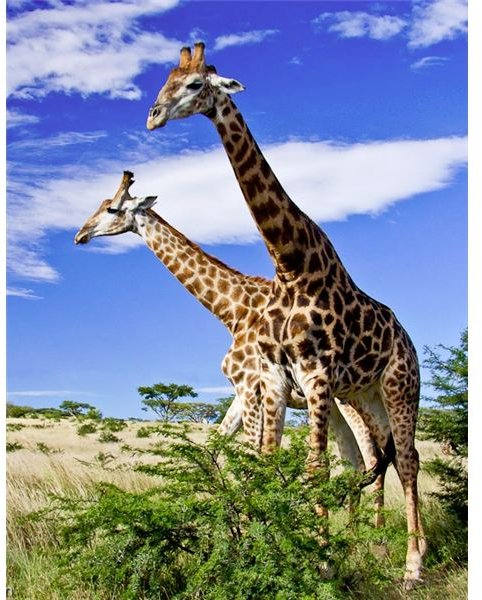Amusing Giraffe and Baby Giraffe Facts: Description, Behavior, Diet & More
The Giraffe
The giraffe is the tallest land animal on Earth. Only one species of giraffe, camelopardalis, exists. The species name was given because people once believed the giraffe was a combination of a camel and a leopard. There are nine recognized subspecies that can be found living among tall trees in southern, central and eastern Africa. Below are more interesting giraffe and baby giraffe facts.
Description
The male giraffe can stand up to 19 feet tall and can weigh up to 3,000 pounds. The female can reach a height of 16 feet and weigh around 2,000 pounds. A baby giraffe is approximately six feet tall and weighs up to 150 pounds at birth. The baby can grow as much as an inch a day. An adult’s neck can reach a length of six feet and weigh up to 600 pounds. Despite their long necks, they have the same number of vertebrae as humans. However, each of their seven vertebrae can be over 10 inches long. The heart can be up to two feet long and weigh around 25 pounds, the blue-black tongue is 18 to 20 inches long and the lungs can hold up to 12 gallons of air. Coat patterns differ depending on the subspecies, but no two giraffes have the exact same pattern. Males and females have two distinct horns called ossicones. Males form up to three other horn-like bumps as they age.
Behavior
Giraffes are social, non-territorial creatures. They are often seen in herds that vary in sexes and ages. Normally there are 10 to 20 giraffes in each herd. They can leave the herd and join another if they wish. They eat during the day and sleep at night. They normally sleep standing up, with their head lying on a hind leg (forming an arch). They don’t vocalize often. When they do, the sounds they make include moans, hisses, whistles, grunts and snorts. When walking, they move both right legs forward, then both left. Giraffes can walk about 10 miles per hour over a long distance and run up to 35 miles per hour over a short distance.
Diet
Giraffes consume up to 75 pounds of food a day. They eat leaves in treetops, mostly from the acacia tree, and occasionally they will eat grass and fruits. The acacia tree has long thorns which the giraffe is able to reach around with its long tongue. The thorns prevent most other animals from eating the leaves. If a giraffe was to swallow a thorn, its thick saliva will carry it down safely, preventing an injury. Giraffes can go several days without drinking because the leaves they eat contain a lot of water.
Reproduction

Females become sexually mature when they are 3 to 4 years old but they do not breed for at least another year. Breeding occurs every 20 to 30 months and the gestation period lasts 14 to 15 months. The mother normally gives birth to one baby; twins are uncommon. The mother gives birth while standing or walking, causing the baby giraffe to fall head first to the ground from a 5 to 6 foot drop. This doesn’t hurt the baby, but it does cause him or her to take a big breath. The baby can stand 30 minutes after being born to nurse. At 10 hours of age, he or she is able to run with its mother. The baby will start eating leaves at 2 months old and will be fairly independent at 6 months old.
Predators
Predators include lions, leopards, hyenas and crocodiles. Adults are most vulnerable when bending over to take a drink of water. When standing, they are capable of running away and delivering deadly blows with their front legs. Sick, old and baby giraffes are at a higher risk of being killed.
More Information
The following are more interesting giraffe and baby giraffe facts:
• The size of an adult’s hoof can be up to 12 inches across.
• Small birds will land on their backs and eat insects on their fur.
• When mothers go to eat, one will stay behind to babysit all the baby giraffes.
• Humans hunt giraffes for their meat, coats and tails. Coats are used for shield coverings and the tails are used for fly whisks and good luck bracelets.
• Only one subspecies, the Uganda giraffe, is considered endangered.
• The average life span is 15 years in the wild.
References
National Geographic: https://animals.nationalgeographic.com/animals/mammals/giraffe/
African Wildlife Foundation: https://www.awf.org/content/wildlife/detail/giraffe
San Diego Zoo: https://www.sandiegozoo.org/animalbytes/t-giraffe.html
Animal Diversity Web: https://animaldiversity.ummz.umich.edu/site/accounts/information/Giraffa_camelopardalis.html
Photo Credit:
